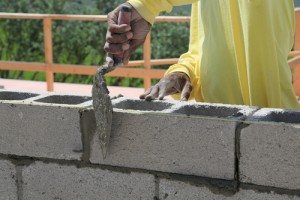 Concrete masonry units aren’t used to build a large proportion of housing in the Midwest, but there are still plenty of applications where this type of wall is needed and additional insulation is also needed. Fortunately, there are a number of tactics and products available to help builders insulate concrete. Here are three common options.
Concrete masonry units aren’t used to build a large proportion of housing in the Midwest, but there are still plenty of applications where this type of wall is needed and additional insulation is also needed. Fortunately, there are a number of tactics and products available to help builders insulate concrete. Here are three common options.
- False wall
While this method is not without its limitations, but is an adequate, low-cost solution. By framing a non-structural, false wall out of 2 x 4 sections along the inside face of the block wall and adding conventional rolls of fiberglass batts, increased insulation is possible. This also adds a nailing surface and a concealed chase for wiring and plumbing. The downside would be decreased square footage. There’s also additional concerns about moisture and mold growth with this method, but that can be mitigated by adding a vapor retarder or housewrap on the outside face.
- Foam in-place insulation
Since CMU walls are often left at least partially unfilled by grout, there’s an opportunity to add foam in-place insulation. This is a fairly simple process that only involves making injection holes in the concrete with a drill. These holes can’t be patched, however, until the insulation cures, which typically takes about 72-hours. An additional contractor is also necessary and this method generally adds at least a couple days to the project schedule. But, the result is a more thermally efficient and more stable wall.
- Foam panels
This final method, which is generally regarded as the most effective option, actually calls for multiple insulation efforts. It starts with the installation of rigid foam panels to the inside face of the block wall. When the foam panels feature a foil face, they act as an air and moisture barrier in addition to adding thermal efficiency. Flashing tape along abutting joints then serve to block air along the wall and wood furring strips can be added to serve as nailers for drywall. Finally, a housewrap can be added to the exterior face and more flashing tape to bridge all joints. This creates a complete and effective air-moisture barrier.
Whatever your needs, we at Maxwell Supply in Tulsa are here to help. Stop by and see us for expert recommendations and a wide variety of products.